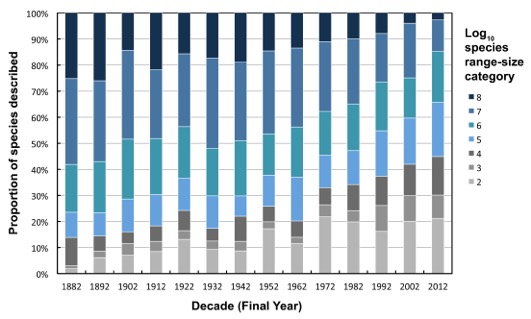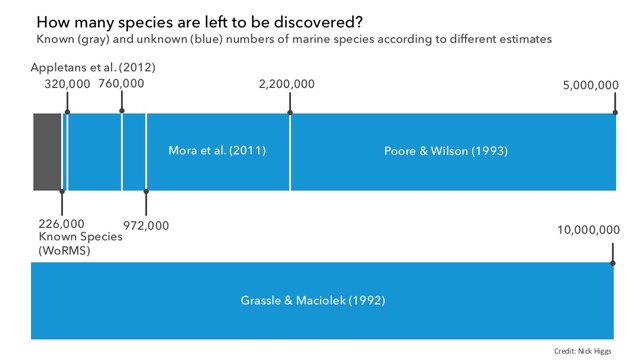Although various attempts at ocean exploration occurred throughout the world, exploration of the deep sea did not begin in earnest until the 19th century, with the voyage of the HMS Challenger generally considered to be the first scientific expedition to explore the deep sea. The papers and books published from this expedition are among the first scientific products related to deep-sea biological studies. Since this time, major advancements in technology have increased our ability to study the very deepest parts of the ocean. Our continued efforts regularly identify new species, communities, and reveal the processes that generate and maintain this diversity. We have advanced from believing the deep sea was void of life to Hessler and Sanders’ (1967) landmark study that revealed the deep benthos to be home to an astonishing diversity and abundance of life. This paper has become one of the most-cited papers in the field of deep-sea biology. Other key, highly-cited papers and advances in deep-sea research include but are not limited to Dayton and Hessler (1972), Corliss et al., (1979), Smith and Hessler (1987), Levin et al. (1991), Etter and Grassle (1992), Grassle and Maciolek (1992), Rex et al. (1993), Sibuet and Olu (1998), Sogin et al (2006).
In this spirit of these influential papers and the contributions their authors made, the Deep-Sea Biology Society seeks to acknowledge a major advancement in deep-sea research. To honor current and major advancements in research that either reveal key information, challenge our current notions, or generally bolster the field of deep-sea biology, the Deep-Sea Biology Society is hold an annual award for the Landmark Paper in Deep-Sea Biology Research.
The winner of the Landmark Paper in Deep-Sea Biology Research for 2015 is “Biases in biodiversity: wide-ranging species are discovered first in the deep sea” by Nicholas D. Higgs and Martin J. Attrill (Marine Institute, Plymouth University, Plymouth, UK).
Despite nearly 50 years of deep-sea research since Hessler and Sanders’ (1967) demonstrated that the deep benthos harbors an astonishing diversity and abundance of life, estimates of global species richness and diversity in the deep sea are hindered by the limited area of the deep sea that has been explored. This issue is further hindered by uncertainty in estimates of the number of undiscovered species and rare species and their range sizes.
Many of these estimates are based on relative comparisons with other marine habitats. For example, deep-sea species are often characterized as having comparatively large geographic ranges but Higgs and Attrill (2015) suggest that this might be an artifact of our current biodiversity records. They tested the hypothesis that wide-ranging species tend to be described earlier using spatial and species data from the Ocean Biogeographic Information System (OBIS) and World Register of Marine Species (WoRMS).
They found a historical bias in species descriptions, with wide-ranging species over-represented in current catalogs of deep-sea species (deeper than 300 m) and therefore “suggest that current estimates of deep-sea species richness underestimate the true proportion of narrow-ranged species and hence total species in the deep oceans.” Of course, recent studies have also shown that many of these supposedly cosmopolitan species are actually cryptic species complexes, adding a further challenge to the notion that the deep sea is home to a higher proportion of wide-ranging species.

Author Information
Nick Higgs is a marine ecologist, recently appointed as Deputy Director of the Marine Institute at Plymouth University. Nick ‘grew up’ in the deep-sea research community and is an enthusiastic supporter of the Deep Sea Biology Society, having attended the last three DSBS meetings. A particular interest in deep-sea biodiversity began with his masters research on species richness patterns in deep-sea brittle stars, before undertaking a PhD on the ecology of whale-fall ecosystems. He is also part of the World Register of Deep-Sea Species project and Deep Sea ID app team.
Martin Attrill is Professor of Marine Ecology and Director of the Marine Institute at Plymouth University. Martin began his research career working on the ecology of deep-sea decapods from the Discovery Collections, before diversifying into the ecology of estuarine and seagrass ecosystems. More recently, he has worked on marine conservation and management issues.
Literature cited
Corliss, J.B., Dymond, J., Gordon, L.I., Edmond, J.M., 1979. Submarine thermal springs on the Galapagos Rift. Science 203, 1073-1082.
Dayton, P.K., Hessler, R.R., 1972. Role of biological disturbance in maintaining diversity in the deep sea. Deep-Sea Research 19, 199-208.
Etter, R.J., Grassle, J.F., 1992. Patterns of species diversity in the deep sea as a function of sediment particle-size diversity. Nature 360, 576-578.
Grassle, J.F., Maciolek, N.J., 1992. Deep-sea species richness: regional and local diversity estimates from quantitative bottom samples. American Naturalist 139, 313-341.
Hessler, R.R., Sanders, H.L., 1967. Faunal diversity in the deep-sea Deep Sea Research and Oceanographic Abstracts. Elsevier, pp. 65 IN25, 71-70 IN28-78.
Levin, L.A., Huggett, C.L., Wishner, K.F., 1991. Control of deep-sea benthic community structure by oxygen and organic-matter gradients in the eastern Pacific Ocean. Journal of Marine Research 49, 763-800.
Rex, M.A., Stuart, C.T., Hessler, R.R., Allen, J.A., Sanders, H.L., Wilson, G.D., 1993. Global-scale latitudinal patterns of species diversity in the deep-sea benthos. Nature 365, 636-639.
Sibuet, M., Olu, K., 1998. Biogeography, biodiversity and fluid dependence of deep-sea cold-seep communities at active and passive margins. Deep Sea Research Part II: Topical Studies in Oceanography 45, 517-567.
Smith, C.R., Hessler, R.R., 1987. Colonization and succession in deep-sea ecosystems. Trends in Ecology & Evolution 2, 359-363.
Sogin, M.L., Morrison, H.G., Huber, J.A., Welch, D.M., Huse, S.M., Neal, P.R., Arrieta, J.M., Herndl, G.J., 2006. Microbial diversity in the deep sea and the underexplored “rare biosphere”. Proceedings of the National Academy of Sciences 103, 12115-12120.

